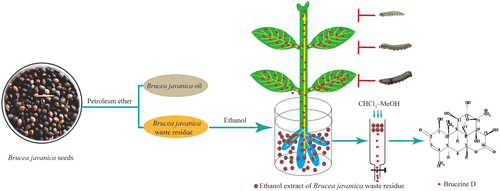当前位置:
X-MOL 学术
›
J. Agric. Food Chem.
›
论文详情
Our official English website, www.x-mol.net, welcomes your feedback! (Note: you will need to create a separate account there.)
Bruceine D Isolated from Brucea Javanica (L.) Merr. as a Systemic Feeding Deterrent for Three Major Lepidopteran Pests
Journal of Agricultural and Food Chemistry ( IF 6.1 ) Pub Date : 2019-03-22 00:00:00 , DOI: 10.1021/acs.jafc.8b06511 Genlin Mao , Yongqing Tian , Zheng Sun , Jianlin Ou , Hanhong Xu
Journal of Agricultural and Food Chemistry ( IF 6.1 ) Pub Date : 2019-03-22 00:00:00 , DOI: 10.1021/acs.jafc.8b06511 Genlin Mao , Yongqing Tian , Zheng Sun , Jianlin Ou , Hanhong Xu

|
Systemicity is a desirable property for insecticides. Many phytochemicals show good systemic properties and thus are natural sources of novel systemic insecticidal ingredients. Bruceine D, a quassinoid, was identified in Brucea javanica (L.) Merr. and displayed outstanding systemic properties and excellent antifeedant activity against the diamondback moth (DBM, Plutella xylostella L.), beet armyworm (Spodoptera exigua Hübner), and cotton leafworm (Spodoptera litura Fabricius). Its antifeedant effect on third instar larvae of DBM was approximately 6.2-fold stronger than that of azadirachtin. When bruceine D was applied to roots at a concentration of 100 μg/mL for 24 and 48 h, its concentration in flowering Chinese cabbage (Brassica campestris L. ssp. chinensis var. utiliz Tsen et Lee) leaves was 38.69 μg/g (fresh weight, FW) and 108.45 μg/g (FW), respectively. These concentrations could achieve 93.80% and 96.83% antifeedant effects, which were significantly greater than those of azadirachtin. Similar to azadirachtin, bruceine D also posed a potent growth inhibition effect on insect larvae. After feeding with 20 μg/g bruceine D, no pupae were observed. The results demonstrated that bruceine D is an effective botanical insect antifeedant with outstanding systemic properties, causing potent pest growth inhibitory activity.
更新日期:2019-03-22

































 京公网安备 11010802027423号
京公网安备 11010802027423号